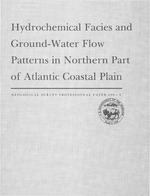Hydrochemical facies and ground-water flow patterns in northern part of Atlantic Coastal Plain
Links
- More information: National Geologic Map Database Index Page (html)
- Document: Report (5.06 MB pdf)
- Plate: Plate 1 (7.25 MB pdf)
- Download citation as: RIS | Dublin Core
Abstract
The part of the Atlantic Coastal Plain that extends from New Jersey through Virginia was selected as a suitable field model in which to study the relationships between geology, hydrology, and chemical character of ground water. The ground-water flow pattern is the principal hydrologic control on the chemical character of the water. Within the Coastal Plain sediments, the proportions of clay, glauconitic sand, and calcareous material are the principal lithologic controls over the chemistry of the water.
A subsurface body of salt water extends from southern New Jersey through southern Virginia and occupies the deposits deeper than about 500 feet below land surface in the eastern part of the Coastal Plain. The position of its top is determined by the relative head, which in turn is influenced by topography, drainage density, and the thickness and permeability of the Coastal Plain sediments.
Hydrochemical facies is a term used in this paper to denote the diagnostic chemical aspect of ground-water solutions occurring in hydrologic systems. The facies reflect the response of chemical processes operating within the lithologic framework and also the pattern of flow of the water. The distribution of these facies is shown in trilinear diagrams and isometric fence diagrams and on maps showing isopleths of chemical constituents within certain formations. The occurrence of the various facies within one formation or within a group of formations of uniform mineralogy indicates that the ground-water flow through the aquifer system modifies the distribution of the facies.
Flow patterns of fresh ground water shown on maps and in cross sections have been deduced from available water-level data. These patterns are controlled by the distribution of the higher landmasses and by the depth to either bedrock or to the salt-water interface. The mapping of hydrochemical facies shows that at shallow depths within the Coastal Plain (less than about 200 ft) the calcium-magnesium cation facies generally predominates. The bicarbonate anion facies occurs within more of the shallow Coastal Plain sediments than does the sulfate or the chloride facies. In deeper formations, the sodium chloride character predominates. The lower dissolved-solids content of the ground water in New Jersey indicates less upward vertical leakage than in Maryland and Virginia, where the shallow formations contain solutions of higher concentration.
Study Area
| Publication type | Report |
|---|---|
| Publication Subtype | USGS Numbered Series |
| Title | Hydrochemical facies and ground-water flow patterns in northern part of Atlantic Coastal Plain |
| Series title | Professional Paper |
| Series number | 498 |
| Chapter | A |
| DOI | 10.3133/pp498A |
| Year Published | 1966 |
| Language | English |
| Publisher | U.S. Government Printing Office |
| Publisher location | Washington, D.C. |
| Description | Report: iv, 42 p.; 1 Plate: 54.00 x 41.50 inches |
| Larger Work Title | Hydrology of aquifer systems |
| Country | United States |
| State | Delaware, Maryland, New Jersey, Pennsylvania, Virginia |
| Online Only (Y/N) | N |
| Additional Online Files (Y/N) | N |


